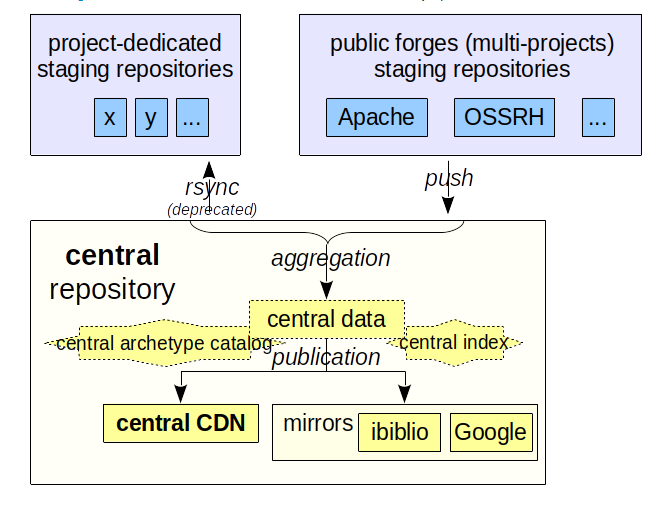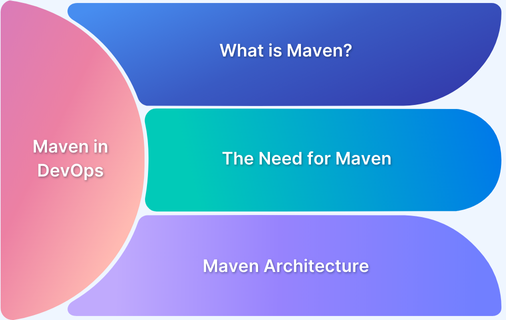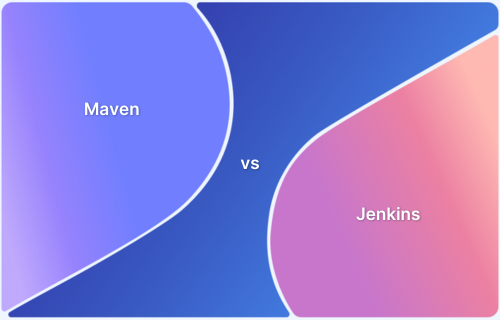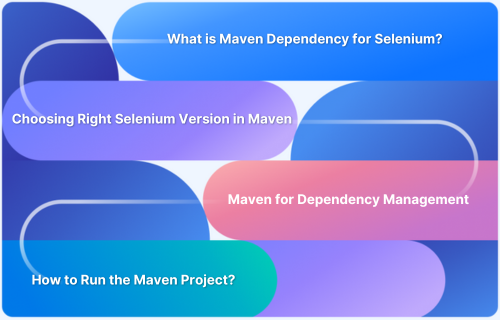In 2025, over 4705 companies have started using Apache Maven as a Build Automation tool globally. Maven effectively automates the source code compilation and dependency management, assembles binary codes into packages, and executes test scripts.
Overview
What is Maven in Jave
Apache Maven is a build automation and project management utility commonly used in Java development. It simplifies the build process, dependency management, and documentation of projects following the “convention over configuration” principle to reduce setup time.
Maven’s Objectives
- Streamlining the Build Process
- Making the Build Process Consistent
- Giving Detailed Project Information
- Encouraging Best Development Practices
Benefits of Using Maven in Java
- Simple project setup
- Supports external deployment and ANT tasks
- Facilitates consistency
- Works on multiple projects simultaneously
- Enhances communication and resolves backward compatibility issues
In this guide, learn in detail about Maven in Java covering the installation process, usage, architecture, objectives, project structure, benefits, best practices and more.
What is Maven in Java
Apache Maven is a build automation and project management utility commonly used in Java development. It simplifies the build process, dependency management, and documentation of projects following the “convention over configuration” principle to reduce setup time.
To develop a new Java project with Maven, one can use the Maven Archetype Plugin, which offers project templates (archetypes) for creating standardized project structures.
One such widely used archetype is maven-archetype-quickstart. T
o create a project using this archetype, execute the following command in the terminal:
mvn archetype:generate -DarchetypeArtifactId=maven-archetype-quickstart
Read More: How to Create Maven Project in Eclipse
Features of Java
The following features of Java help it to integrate with Maven seamlessly:
- Standard Directory Structure: Java’s convention for src/main/java and src/test/java aligns with Maven’s project layout.
- Package Management: Java’s package/namespace system integrates seamlessly with Maven’s groupId and artifactId for dependency organization.
- Bytecode Portability: Java’s JVM compatibility allows Maven to build platform-independent artifacts (JAR/WAR).
- Dependency Ecosystem: Java’s reliance on external libraries (JARs) is streamlined via Maven’s Central Repository.
- Testing Frameworks: Java’s JUnit/TestNG support works natively with Maven plugins (Surefire, Failsafe) for automated testing.
Maven’s Objectives
Maven’s primary objective is to enable developers to quickly and comprehensively understand the state of a project. It achieves this through several key strategies:
- Streamlining the Build Process: Maven does the heavy lifting in compilation, testing, and packaging, minimizing manual intervention and optimizing the development process.
- Making the Build Process Consistent: Sticking to a uniform project structure and the Project Object Model (POM), Maven maintains consistency in projects, making it simpler to onboard and collaborate with developers.
- Giving Detailed Project Information: Maven produces useful documentation, such as lists of dependencies, change histories, and test results, automatically from the source code and configuration of the project, and this increases transparency and maintainability.
- Encouraging Best Development Practices: Maven promotes best development practices, including keeping source and test code in different directories, adhering to naming conventions for test classes, and including testing in the build lifecycle, thus encouraging code quality and reliability.
Read More: Maven Cucumber Reporting
Working of Maven in Java Development
Using Maven, you can create Java deliverables like JAR, EAR, and WAR files. The pom.xml file helps you to do these tasks. These XML files contain your Java project’s name, group ID, and other valuable information. Based on this information, Maven creates the JAR (Java archives) files and transfers them to the Maven repository. You can download and use the JAR files for compilation and testing purposes.
Also Read: What is the role of Maven in DevOps?
When to Use Maven
Apache Maven is best suited for Java projects requiring structured build automation, dependency management, and standardized workflows. It shines in scenarios like managing complex dependencies (e.g., frameworks like Spring or Hibernate), where its ability to auto-resolve libraries from repositories like Maven Central saves significant effort.
Maven’s convention-over-configuration approach enforces a consistent project layout (src/main/java, src/test/java), making it ideal for teams prioritizing uniformity across projects. It also excels in multi-module setups, simplifying builds for interconnected components.
It also integrates seamlessly with CI/CD pipelines (Jenkins, GitHub Actions) for automated testing, packaging, and deployment. Additionally, its plugin ecosystem supports tasks like code quality checks, test reporting, and documentation generation, reducing manual scripting.
Here’s a quick comparison of Maven and its alternatives, so that you get a better idea od when to use what:
| Scenario | Maven | Gradle | Ant |
|---|---|---|---|
| Convention over configuration | Standardized, minimal setup | Flexible with Groovy/Kotlin DSL | Requires manual scripting |
| Dependency Management | Robust | Robust | Requires Ivy add-on |
| Build Speed | Slower (XML parsing) | Faster (incremental builds) | Slow for large projects |
Maven Uses in Java Development
Here are the different areas where Maven is used in Java development:
1. Project Management
Creating and organizing Java projects with Maven
Maven creates Java projects from its templates. Then it creates a project directory. Your source code will be put in the folder of that directory. Maven will create a pom.xml file for your project. Then it manages your project details in the form of ‘Project Reports’ and the ‘Project Information’. With the help of the Project Object Model, it preserves all metadata of your project under the central repository.
Managing project structure and resources
Maven maintains a standard directory structure. With the src directory, it manages the source and the test codes. The main build of your project is placed in the main directory. The target directory contains the compiled classes of your Maven project. You will get the unit test codes from the test directory. Your project resources have been stored in the resources directory.
Managing project dependencies and version control
For complex and multi-module projects, Maven provides a high standard of control over the dependencies. It specifies the version of the build to be used when there will be multiple dependencies in a project. It can include and exclude dependencies depending on the present stage of the build.
Again, there are different dependency scopes of Maven, such as – compile, runtime, test, system, import, etc.
Read More: Maven Dependency Management with Selenium
2. Build Automation
Building Java projects with Maven
Maven starts the automation activities by downloading the dependencies. Later it manages the source code compilation, the binary codes, packaging, test execution, and reporting. This disciplined way provides optimized automation. It allows you to release your product after repeated validation and modification.
Compilation, packaging, and artifact generation
This tool interprets source code into binary code for large applications. It compiles every class into byte codes and accumulates them within a single package. The packaging completes the building process. Then Maven will generate an output, called artifact. An artifact might be a JAR, EAR, or other executable file.
Automated testing and reporting
As it follows automation testing, you can easily test thousands of lines of your code with this tool. After finishing the test, you need to put that code in the reporting section of the POM file. Then by running the ‘mvn site’ command, you can generate the test report.
3. Dependency Management
Managing project dependencies with Maven
It’s a quite difficult task to manage the version of dependency for a large project. But Maven helps to manage and standardize the version for all of your team members. So, it provides a built-in structure to write your codes. If you want to change the dependency version, you can do it by updating the version in the XML file.
Resolving and retrieving external libraries and frameworks
Maven allows you to use external libraries in your Java project. These libraries handle complex as well as common functionalities. For example, if you want to use the current date and time in a Java project, you can use the Joda Time libraries.
Maven also supports external frameworks to build the projects. The Maven community offers several frameworks to use. You can use them while developing your applications.
Dependency version control and conflict resolution
Maven always keeps a similar dependency version for a Java project for your team members. Thus it removes unnecessary conflicts among your team members about the dependency. The plugins help to update the versions and provide update reports in this regard. The version numbers follow some vital standards to avoid conflicts.
4. Continuous Integration and Deployment
Integrating Maven with CI/CD tools
The best outcomes happen when you choose the Maven Jenkins or Maven Travis CI. Maven is a build tool and Jenkins, and Travis CI are the integration tools. These integration tools control every segment of the CI/CD pipeline and offer successful DevOps for your Maven projects.
Automating build and deployment processes
The Maven Jenkins plugin helps to package and deploy your code. Usually, Jenkins deploys artifacts into the remote repositories of Maven. Travis CI supports Maven for Java and it helps in project build, testing, and deployment. Also, it supports continuous integration for the projects hosted on GitHub, Bitbucket, etc.
Generating release artifacts and distribution packages
In DevOps, Maven simplifies the building procedure of your projects. Additionally, it includes releasing artifacts, package distribution, and more. The release plugin saves time from a lot of manual tasks. It releases artifacts in two steps: prepare and perform.
The preparation step involves preparing a release in SCM and recording the SCM in a local copy. Maven performs the SCM release from a specific tag or the tag that is involved in the previous release.
How to Use Maven in Java
Apache Maven is a complete solution for managing the build, testing, and deployment process in Java projects. It allows for the separation of unit tests and integration tests. This is done through the use of the Surefire plugin for unit tests and the Failsafe plugin for integration tests. This ensures the build times are optimized and the testing is efficiently managed.
Apart from build management, Maven assists in dependency management. Maven automatically manages the downloading, installation, and versioning of the required libraries by specifying dependencies in the pom.xml file. This feature is useful in large projects where various modules need different versions of the same dependency. Maven can easily resolve such conflicts.
Read further to know in detail about using Maven
How to Install Maven?
Below are the steps to install Maven on Windows. For installation on Ubuntu or MacOS, visit here.
Step 1: Install Java Development Kit (JDK)
- Check if Java is installed: Open Command Prompt and run: java -version
- If not installed: Download and install the latest JDK from Oracle or OpenJDK.
Step 2: Download and Extract Maven
- Visit the Apache Maven Downloads page.
- Download the latest Binary zip archive
(example)
apache-maven-3.9.9-bin.zip
- Extract the ZIP file to a desired location, e.g.
C:\Program Files\Apache\Maven
Step 3: Configure Environment Variables
- Open System Properties > Environment Variables.
- Under System Variables, click New and add:
- Variable name: MAVEN_HOME
- Variable value:
C:\Program Files\Apache\Maven\apache-maven-3.9.9
- Find the Path variable, click Edit, and add:
%MAVEN_HOME%\bin
Step 4: Verify Installation
- Open a new Command Prompt window.
- Run mvn -version to confirm Maven is correctly installed.
How to Build a Maven Project
1. Ensure Maven and Java are Installed
- Verify Java installation:
java -version
- Verify Maven installation:
mvn -version
- Ensure that the JAVA_HOME environment variable is set correctly
2. Create a New Maven Project (Optional)
If there is no existing project, one can generate one using Maven’s archetype plugin:
mvn archetype:generate -DgroupId=com.example -DartifactId=my-app \ -DarchetypeArtifactId=maven-archetype-quickstart -DinteractiveMode=false
This command creates a basic project structure with a sample pom.xml file.
3. Navigate to the Project Directory
Change into the project’s root directory:
cd my-app
4. Build the Project
Execute the following command to clean any previous builds and compile the project:
mvn clean install
This command performs several tasks:
- clean: Removes previous build artifacts.
- compile: Compiles the source code.
- test: Runs unit tests.
- package: Packages the compiled code into a JAR/WAR file.
- install: Installs the package into the local Maven repository for reuse.
5. Run the Application
After building, run the application using the java command:
java -cp target/my-app-1.0-SNAPSHOT.jar com.example.App
Replace com.example.App with the application’s main class.
Read More: Maven Dependency Management with Selenium
Maven Project Structure Overview
A typical Maven project follows this directory structure:
my-app/ ├── pom.xml └── src/ ├── main/ │ ├── java/ │ │ └── com/ │ │ └── example/ │ │ └── App.java │ └── resources/ └── test/ ├── java/ │ └── com/ │ └── example/ │ └── AppTest.java └── resources/
- pom.xml: Contains project configuration and dependencies.
- src/main/java: Holds the main application source code.
- src/test/java: Contains test classes.
Understanding Maven framework
Apache Maven is a widely used open-source build tool and project management software, mostly intended for Java applications. It makes the process of building easier by handling tasks like compilation, testing, packaging, and deployment.
1. Project Object Model (POM)
At the core of Maven’s capabilities lies the Project Object Model (POM), an XML file that represents the structure, dependencies, and settings of a project. By following a standard directory structure and build life cycle, Maven encourages consistency among projects and teams.
Here’s a simple example of a basic pom.xml file for a simple Java project using Maven:
<?xml version="1.0" encoding="UTF-8"?> <project xmlns="http://maven.apache.org/POM/4.0.0" xmlns:xsi="http://www.w3.org/2001/XMLSchema-instance" xsi:schemaLocation="http://maven.apache.org/POM/4.0.0 http://maven.apache.org/xsd/maven-4.0.0.xsd"> <modelVersion>4.0.0</modelVersion> <groupId>com.example</groupId> <artifactId>my-app</artifactId> <version>1.0-SNAPSHOT</version> <packaging>jar</packaging> <name>My App</name> <description>A simple Maven project</description> <properties> <maven.compiler.source>17</maven.compiler.source> <maven.compiler.target>17</maven.compiler.target> </properties> <dependencies> <!-- JUnit for testing --> <dependency> <groupId>junit</groupId> <artifactId>junit</artifactId> <version>4.13.2</version> <scope>test</scope> </dependency> </dependencies> </project>
Key Elements:
- <groupId>: Defines the group (often the organization or company) that the project belongs to.
- <artifactId>: Specifies the name of the project.
- <version>: Indicates the current version of the project.
- <packaging>: Determines the packaging type (e.g., jar, war).
- <properties>: Sets project-wide properties, such as the Java version for compilation.
- <dependencies>: Lists external libraries required by the project. In this example, JUnit is included for testing purposes.
Additionally, Maven’s integration with repositories allows for efficient dependency management, ensuring that projects have access to the necessary libraries and plugins. This structured approach not only streamlines development workflows but also enhances collaboration and maintainability in software projects.
Read More: What is POM in Maven
2. Maven repositories and dependencies
The Maven repository stores all your projects’ jars, plugins, library jars, other artifacts, and the dependencies are the third-party software required by your project. You will find three types of repositories in Maven – local, central, and remote. The local repository stores all the Maven dependencies.
The Maven community handles the central repository. If you don’t find a dependency in your local repo, you can find it in the central repo. Again the developers can utilize their customized repository. That is known as the remote repository.
Source: Maven
3. Maven Plugins and Lifecycles
The Maven plugins add goals to your projects. The goals represent the functionalities of the plugins – what it can do for your project.
For example, the Modello plugin generates the Java source codes from a model. The goals are a significant element of your build lifecycle. You have to bind more than one goal in each build phase.
The build lifecycle is made up of different phases. The default lifecycle consists of the following phases:
- Validate: It authorizes your project’s correctness and ensures necessary data are available.
- Compile: It compiles the source code of your project.
- Test: It tests your compiled source codes with the unit testing frameworks.
- Package: In this phase, your source code will be packaged as a deliverable.
- Verify: It ensures your code’s quality with an integration test.
- Install: Your code will be installed in the local repository.
- Deploy: Finally, the code is ready to share with the other developers.
Also Read: SDLC phases and SDLC Models
4. Maven’s convention-over-configuration approach
The convention over configuration approach makes the developers’ tasks easier as they don’t need to create any project build process. Maven creates the build process and automates it. Also, the developers don’t need to store the configuration details within the pom.xml file.
Maven is enough to manage these tasks for the developers. The Maven plugins maintain the project build and management-related works. So, this approach saves valuable time for the developers.
What is Maven Life Cycle?
Maven lifecycle is a well-defined sequence of phases that manage the build and deployment process. Each phase is executed in order, and invoking a phase will also execute all preceding phases in the lifecycle. There are three built-in lifecycles:
1. Default Lifecycle: Handles project deployment.
Phases include:
- validate: Validate the project is correct and all necessary information is available.
- compile: Compile the source code.
- test: Test the compiled source code.
- package: Package the compiled code into a distributable format, such as a JAR.
- verify: Run checks to verify the package is valid and meets quality criteria.
- install: Install the package into the local repository for use as a dependency in other projects.
- deploy: Copy the final package to the remote repository for sharing with other developers.
2. Clean Lifecycle: Handles project cleaning.
Phases include:
- pre-clean: Perform actions before cleaning.
- clean: Remove files generated at build-time.
- post-clean: Perform actions after cleaning.
3. Site Lifecycle: Handles the creation of the project’s site documentation.
Phases include:
- pre-site: Perform actions before generating the site documentation.
- site: Generate the project’s site documentation.
- post-site: Perform actions after generating the site documentation.
- site-deploy: Deploy the generated site documentation to the specified server.
What Is Maven Repository?
Maven repositories are directories that store project artifacts, such as JAR files, plugins, and other dependencies. They play a crucial role in Maven’s dependency management system.
Types of Repositories:
- Local Repository: Located on the developer’s machine, typically at ~/.m2/repository. Maven downloads dependencies to this repository for reuse in future builds.
- Central Repository: A remote repository provided by the Maven community. It hosts a vast collection of commonly used libraries and is the default source for dependencies.
- Remote Repository: Custom repositories set up by organizations to host internal or third-party artifacts. Examples include repositories managed by tools like Sonatype Nexus or JFrog Artifactory.
When building a project, Maven checks the local repository for required dependencies. If not found, it retrieves them from the central or specified remote repositories and caches them locally.
Read More: What is Maven Dependency?
What Is Maven Architecture?
Apache Maven is a powerful build automation and project management tool primarily used for Java projects. Its architecture is designed to streamline the build process, manage dependencies, and facilitate project documentation.
Key Components:
- Project Object Model (POM): The POM is an XML file (pom.xml) located at the root of a Maven project. It contains information about the project and configuration details (like include project dependencies, plugins, goals, and other settings) used by Maven to build the project.
- Build Lifecycle: Defines the sequence of phases that handle the build process.Each phase represents a stage in the lifecycle, such as compiling code, running tests, and packaging.
- Plugins and Goals: Plugins are collections of goals, where each goal represents a specific task. They enable customization and extension of the build process.
- Repositories: Maven uses repositories to manage project dependencies and plugins. They can be local (on the developer’s machine) or remote (centralized servers).
- Settings and Profiles: settings.xml allows customization of Maven’s behavior, such as repository locations and proxy settings.Profiles enable conditional configuration, allowing different build configurations for different environments.
Read More: Maven vs Jenkins : Key Differences
Benefits of using Maven
Here are the key benefits of using Maven:
- It provides a simple project setup for the developers.
- Maven creates outstanding dependency management for your projects. You can download the JAR files of your projects from the central repository. The dependency management also includes automatic updates.
- As it’s extensible, it can easily write plugins using Java and other scripting languages.
- Maven easily manages your project release and publishes the project in a distribution location.
- Maven can create PDFs, documentation, or websites about your projects. It can do it by using the metadata of the project build.
- It also supports external deployment and ANT tasks.
You can achieve the following benefits from these features –
- You can easily start working on a new project or module without wasting any time.
- It makes your builds consistent throughout the entire process.
- You can easily work on multiple projects simultaneously.
- Maven allows you to keep your JAR files for future usage.
- It enhances communication between different projects and resolves backward compatibility issues.
Disadvantages of using Maven
While Maven offers numerous advantages, such as standardized project structures and efficient dependency management, it also has several disadvantages:
- Steep Learning Curve: Maven’s XML-based configuration tooling and rich lifecycle phase customization process may intimidate beginners.
- Limited Flexibility: Maven is convention-over-configuration, which can limit the ability to customize build processes.
- Performance Issues: Maven’s dependency resolution and build processes can be slow with excessive projects, slowing development speed and efficiency.
- Dependency Management Issues: Maven uses external repositories for dependencies. If an expected dependency is missing or improperly set, it may stop the build process.
- Security Vulnerabilities: Research has indicated that a great percentage of Maven projects are impacted by security vulnerabilities in both their direct and transitive dependencies.
- Documentation and Community Support: Although Maven has comprehensive documentation, it is sometimes outdated or unclear, which complicates troubleshooting and advanced configurations.
Read More: What is the role of Maven in DevOps?
Best Practices for Maven in Java Development
Apache Maven streamlines Java development, but adhering to proven practices ensures efficient and reliable unit testing. Here’s how to optimize the workflow:
- Project Structure: Keep test code (src/test/java) parallel to main code (src/main/java) but strictly separated.
- Test Naming & Execution: Use conventions like *Test.java for test classes to leverage Maven’s Surefire Plugin auto-detection.
- Test Environment: Avoid custom builds for test setup. Instead, configure a dedicated environment using Maven plugins (e.g., maven-surefire-plugin) or frameworks like JUnit/TestNG.
- DevOps & CI/CD:Integrate Maven with CI/CD pipelines (Jenkins, GitHub Actions) for automated testing, reporting, and deployment.
- Cloud Testing: In Selenium-based projects, you can pair Maven with BrowserStack Cloud Grid by adding Selenium dependencies to your pom.xml. This integration enables efficient and scalable cross-browser testing in the cloud.
Conclusion
Apache Maven is regarded as a fundamental tool in the Java development ecosystem. Its robust architecture, centered around the Project Object Model (POM), has streamlined project management and enhanced collaboration by offering a consistent structure, effective dependency handling, and a powerful plugin system.
As Maven progresses to version 4, recent improvements and new features have addressed legacy issues, strengthening its relevance and adaptability in a fast-changing software environment.
Frequently Asked Questions
1. How is Maven different from Jenkins
Maven is a build automation tool that manages dependencies, compiles code, and packages artifacts. Jenkins, on the other hand, is a CI/CD server that automates the process of building, testing, and deploying code, often utilizing tools like Maven within its pipelines.
2. What does Maven manage for your Java projects?
It manages the builds, packages, releases, documentation, test execution, test reports, email listing, and more.
3. How to check your Maven version?
You must run the command mvn –version on the console to check the version.
4. What is the best CI/CD tool for Maven?
Jenkins is the best CI/CD tool for Maven. Also, you can try AWS, MS Azure, GitLab, BitBucket, etc. for the CI/CD pipeline.







